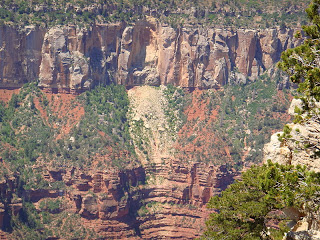About
The desert scrub ecosystem is found
in the lowest elevations of the Grand Canyon, from 4,500 to 1,200 feet
down in elevation.
Historically
Macrofossil assemblages provide a record of desert scrub vegetation for most of the last 13,380 years BP from a hyper arid portion of the lower Colorado River Valley. The desert scrub in the Grand Canyon is considered a Pleistocene desert, which corresponds with the very end of the last glacial period. Geologic formations such as gneiss and schist found at the bottom of the Canyon date back 1,800 million years (Cole).
 |
| Map of Desert Scrub Image Credit to Wikipedia |
 |
| Image Credit to Grand Canyon Association |
The desert scrub community exists just above the river corridor where there is a wide variety of cacti and warm desert scrub species. Approximately 30 species of birds breed in the desert uplands. There are no endemic birds (National Park Services).

Image Source: Buzzle
Numerous insects and arachnids
live in the Grand Canyon desert scrub where some of the common insects found
above 2,000 feet in elevation are orange paper wasps, honey bees, tarantula
hawks, stink bugs, beetles, black ants, and monarch and swallowtail
butterflies. The mammalian fauna in the
woodland scrub community consists of 50 species, mostly rodents and bats (National Park Services).
Human Impact
Most of native plant communities are largely intact, but invasive plants are present due to past livestock grazing, which were introduced by humans (Anderson).
 |
| Invasive plant commonly known as "Sahara mustard" Image source: National Park Services |
However, in 2009, NPS rangers and volunteers began a program to remove invasive species within the area in order to restore its native ecosystem. Organisms considered “pests”, such as beetles that kills trees, presents another dilemma because they are components of the environment. The table below depicts the increase in invasive, non-native plants over time (National Park Services).
 |
| Image Credit to NPS |
Benefits for Humans
Humans benefit from park enjoyment of the Grand Canyon’s ecosystems and sceneries. The key is for the National Park Service to provide for public enjoyment as well as the preservation of the natural ecological processes of the ecosystems.
 |
| Enjoying yoga at the Grand Canyon Image Source: Photo Shelter |
The desert scrublands are not explicitly a protected area, as humans rarely travel through this area. However, certain plateaus of the Grand Canyon are protected areas due to uranium mining.
The Future
The issue of protection and profit is an ongoing conflict. Because the landscape of the Grand Canyon slopes down to the south, the vast and uninterrupted expanse of scenery is rare.
Proposed developments such as the 374-acre Stilo project would break up the view (Ingley). Such visual clutter would create a jarring gash in the scenery. It is essential that the building is aimed to blend in with the scenery if this project is to be pursued.
 |
| Image Credit to The New York Times |
The most likely thing to happen to the desert scrubland is an increase of invasive plant species if NPS does not follow through with maintenance. In addition, increases in temperature will cause the plant and animal species to adapt to severe, changing weather conditions.
National Park Services should keep it their mission to balance priorities of nature conservation within the ecosystem as well as keeping the Grand Canyon a touristic human visitation center. The 1995 General Management Plan continued to emphasize ways to allow still more people to enter the park (NPS). Ecological restoration projects are still hindered by debates over cost, purpose, and priority.

No comments:
Post a Comment